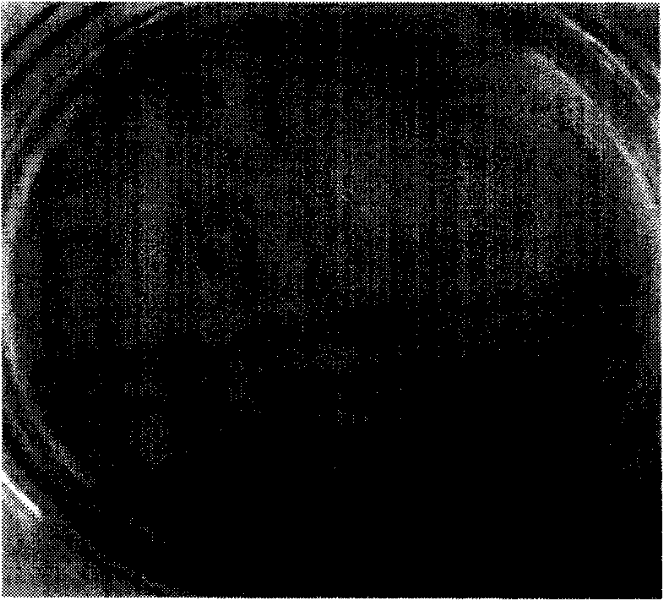Rhodococcus ruber and application thereof in degradation of hydrocarbon compounds
A technology for Rhodococcus rhodochrous and chemical compounds is applied in the fields of microbial biotechnology and environmental biology, and can solve the problems of the degradation of less hydrocarbon compounds and the great environmental harm.
- Summary
- Abstract
- Description
- Claims
- Application Information
AI Technical Summary
Problems solved by technology
Method used
Image
Examples
Embodiment 1
[0058] Example 1: Isolation and screening of bacterial strain Rhodococcus sp.CGMCC NO.2343 provided by the present invention
[0059] The sample comes from the surface sediments in the sea area of Xiamen. Weigh 5g of seabed silt, add 50ml of sterile water to shake for 2h, let it stand for 30min, absorb the clear liquid from the upper layer, and transfer it to the enrichment medium, that is, the medium of inorganic salts plus polycyclic aromatic hydrocarbons. Composition: (NH 4 ) 2 SO 4 , 1.0g; Na 2 HPO 4 , 0.8g; KH 2 PO 4 , 0.2g; MgSO 4 ·7H 2 O, 0.2g; CaCl 2 2H 2 O, 0.1g; FeCl 3 ·6H 2 O, 5 mg; (NH 4 ) 6 Mo 7 o 24 4H 2 O, 1mg; distilled water 1000ml; polycyclic aromatic hydrocarbons 50mg; pH 7.0, sterilized at 121°C for 30min), after culturing for 15 days, transfer 1ml to culture medium containing 50mg / l polycyclic aromatic hydrocarbon inorganic salts for one week, then transfer to fresh 50mg / l polycyclic aromatic hydrocarbon inorganic salt culture solution. ...
Embodiment 2
[0061]Embodiment 2: PCR amplification and sequence determination of the 16S rDNA gene of bacterial strain Rhodococcus sp.CGMCC NO.2343 provided by the present invention
[0062] The colony PCR method was adopted, and the single colony lysate was directly taken as a template for PCR. The PCR primers for amplifying 16S rDNA were a pair of universal primers, 27f: 5’-AGAGTTTGATCCTGGCTCAG-3’, 1492R: 5’-GGTTACCTTGTTACGACT-3’. The PCR reaction conditions were: 94°C for 3min; 30 cycles of 94°C for 30s, 55°C for 30s, and 72°C for 2min; 72°C for 10min. The PCR amplified product was purified and connected to T vector (Shanghai Sangon TA cloning kit), and sent to Shanghai Yingjun Biotechnology Co., Ltd. for sequencing. Blast analysis was performed on the sequencing results and the sequences on Genbank. The length of the sequence is about 1500bp, and the accession number in Genbank is EF634456. The strain of the present invention has great homology with Rhodococcus erythrococcus.
Embodiment 3
[0063] Embodiment 3: the bacterial strain Rhodococcus sp.CGMCC NO.2343 provided by the present invention floats in the characteristic of oily substance
[0064] Cultivate Rhodococcus sp.CGMCC NO.2343 to OD in 2216E medium and be 0.8, collect thalli, inoculate in the 50ml inorganic salt culture fluid containing 4% diesel oil or paraffin after washing with MSM (a batch of cultivation The solution is placed in a test tube with a length of 12 cm and a diameter of 4.5 cm, and another batch is placed in a 150 ml Erlenmeyer flask), and cultivated at 30° C. and 150 rpm for 10 days. Control the non-inoculated parallel samples, and observe the changes of the oily substances floating on the surface of the culture medium. For the test tube culture samples, draw 10ul of the culture solution of each layer and gradually dilute it to 10 -3 、10 -6 、10 -9 , Take 50μl of each dilution and spread on 2216E plate. Count the number of colonies after incubation at 30°C for 48 h.
PUM
 Login to View More
Login to View More Abstract
Description
Claims
Application Information
 Login to View More
Login to View More - R&D
- Intellectual Property
- Life Sciences
- Materials
- Tech Scout
- Unparalleled Data Quality
- Higher Quality Content
- 60% Fewer Hallucinations
Browse by: Latest US Patents, China's latest patents, Technical Efficacy Thesaurus, Application Domain, Technology Topic, Popular Technical Reports.
© 2025 PatSnap. All rights reserved.Legal|Privacy policy|Modern Slavery Act Transparency Statement|Sitemap|About US| Contact US: help@patsnap.com



